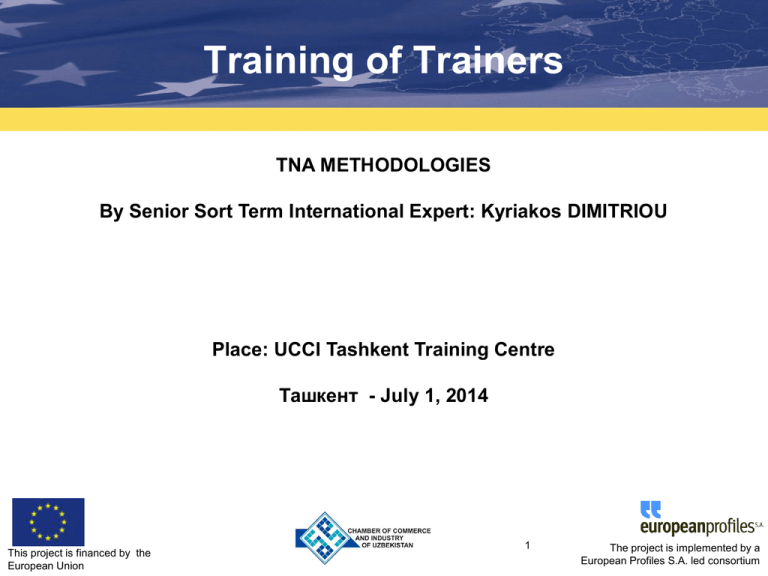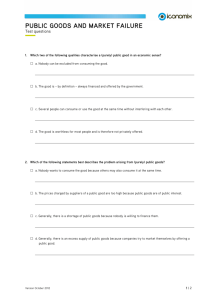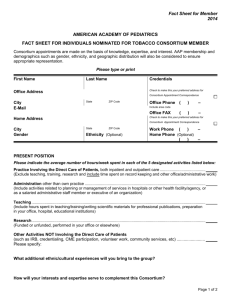companies/ organizations
advertisement

Training of Trainers TNA METHODOLOGIES By Senior Sort Term International Expert: Kyriakos DIMITRIOU Place: UCCI Tashkent Training Centre Ташкент - July 1, 2014 This project is financed by the European Union 1 The project is implemented by a European Profiles S.A. led consortium Training needs analysis (TNA) Training in companies/ organizations is needed to fill in the gap between Employees do have (existing gap) G A P skills and competencies knowledge attitudes behavior the Company or Organization expect or need (expectation’s gap) Analyzing what the training needs are is a vital prerequisite for any effective training program. This project is financed by the European Union 2 The project is implemented by a European Profiles S.A. led consortium TNA defines Without training needs analysis we may miss priority needs, or even cover areas that are not essential. TNA is crucial to define at the same time: the needs the level of skills, abilities and competencies the level of knowledge the expectations the priorities of potential learners and the organization or the company they are working for This project is financed by the European Union 3 The project is implemented by a European Profiles S.A. led consortium TNA - When Training needs analysis is a prior activity. This activity will define somehow the level of delivery, the training objectives and structure. Training needs can be sorted broadly into three types: • those that can be anticipated • those that arise from monitoring • those which result from unexpected problems This project is financed by the European Union 4 The project is implemented by a European Profiles S.A. led consortium TNA– How? Usually is performed by experts that contrast actions done previously, to the expected one. This is combined with competency standards we need to achieve. • The toughest but best way in terms of a quality action is data collection by the trainer himself. TNA is usually carried out through desk Analysis of existing data, questionnaires, personal or group interviews, focus groups, observation etc. This project is financed by the European Union 5 The project is implemented by a European Profiles S.A. led consortium Effective TNA Effective TNA involves systematic planning, analysis and coordination across the organization, to ensure that: organizational priorities are taken into account, duplication of effort is avoided and economies of scale are achieved This project is financed by the European Union 6 The project is implemented by a European Profiles S.A. led consortium TNA - Action checklist 1. Ensure that the identification of training needs is integrated across the organization 2. Anticipate future needs 3. Develop monitoring techniques 4. Investigate unexpected problems 5. Identify the level of need 6. Consider what type of training will be most appropriate This project is financed by the European Union 7 The project is implemented by a European Profiles S.A. led consortium TNA time management Company's size factors Low/ high Low/ low High/ high High / low rate of needs This project is financed by the European Union 8 The project is implemented by a European Profiles S.A. led consortium TNA CYCLE C O S T I N G This project is financed by the European Union Define who evaluati on implemen ting Define what Job analysis 9 R E P O R T I N G The project is implemented by a European Profiles S.A. led consortium The training cycle 1. TNA Follow up Evaluate This project is financed by the European Union Design Deliver 10 The project is implemented by a European Profiles S.A. led consortium Training: Setting the objectives Be specific • Why is this training being carried out? • What knowledge and skills will the participants carry away with them? • How should the participants feel after the training has finished? • Be practical • Check the criteria for goals and objectives Don’t define too many objectives This project is financed by the European Union 11 The project is implemented by a European Profiles S.A. led consortium Structure of training A training action consist of three parts: pretraining phase, the training and post-training phase. The logical structure is Pre - training training • Were we stand now? • We intent … • methods • Means This project is financed by the European Union Post training • Is it applied? • Follow up 12 The project is implemented by a European Profiles S.A. led consortium Structure of training So, in preparing the training structure and content the trainer should consider the following: What I intend to do: goals and objectives How am I going to do it: How will I know if I have succeeded: This project is financed by the European Union content, methods and materials monitoring and evaluation 13 The project is implemented by a European Profiles S.A. led consortium …to know Categories One kind of categorization knowledge, skills, abilities, competencies, etc. is: ie “must know” … It is crucial not to confuse “Categories of Knowledge” with “Degree of Difficulty” This project is financed by the European Union Must Important Useful 14 The project is implemented by a European Profiles S.A. led consortium Using pre - assignments Pre assignment in training is a task that is agreed between the two parties (trainer – learners) to be done in a future time. It is a training technique that include: High involvement by learners / Activation of all senses / Theory knowledge / Research and involvement of resources Setting a pre assignment the trainer must: • Give concrete instructions • Give quantitative limits • Give an example to the learners This project is financed by the European Union 15 The project is implemented by a European Profiles S.A. led consortium Defining a successful training When a training action is successful (prefer to call it effective instead of successful) ? We strongly believe that basic assumption in order to create an effective training activity, is to involve learners in the training action, turn to advantage their experiences, knowledge and skills and taking into account their preferences and particularities. Also the use of various techniques is very helpful. Effectiveness is a continuous process. And the results on how effective the training was, is coming later on… This project is financed by the European Union 16 The project is implemented by a European Profiles S.A. led consortium Development of a training program (Development from the side of the company / organization) There are four major considerations in developing and running a training program: • Planning and ex ante evaluation • Logistics • Implementation • Evaluation This project is financed by the European Union 17 The project is implemented by a European Profiles S.A. led consortium Planning Planning takes into account the findings of TNA and set the objectives and goals Define the area / areas of training delivery Decide the dates of delivery Select the trainer / trainers Determine the staff involved (ex ante evaluation will be part of the evaluation module) This project is financed by the European Union 18 The project is implemented by a European Profiles S.A. led consortium Logistics • • • • • • • Where (place, location) Equipment and materials Human resources Other resources Consumables Fees Other (ie translation etc) This project is financed by the European Union 19 The project is implemented by a European Profiles S.A. led consortium Stages • Objective of the activity • The entry behavior • The “learning contract” • Deciding the content • Sequence planning This project is financed by the European Union • Ways of maximum recall • Planning of resources • The performance • Review - feedback 20 The project is implemented by a European Profiles S.A. led consortium






